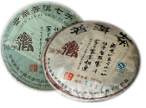 This page is not a real translation but just an automatic translation generated by computer of the original article, written in French language! Its not good... but better than nothing!
This page is not a real translation but just an automatic translation generated by computer of the original article, written in French language! Its not good... but better than nothing!Want to help us do diffuse puerh tea culture in english, by providing a better (or corrected) translation?
Please contact us!

Luo Hou You is a medium-sized producer of the region Zhen Yuan, to Pu'Er that I am since 2008 and I've spent a full article there are quite a few years ago. Based in the village of Shan Zhai Kucong , Luo Hou You specializes in teas and Ailao Mountains Wuliang , especially the villages of the region Zhen Yuan .




- 1.Village Zhenyuan
- 2.tea trees in Zhenyuan
- 3.Luo Hou You to Zhenyuan 2010
- 4.Luo Hou You to Bing Dao 2014
If in his debut Luo Hou You produced a variety of cakes , raw and fermented , this producer assagit its range since 2011 and focuses on both quality products:raw wafer produced each year, a fermented pancake produced one year two .
Something is against left from its beginning:the habit of giving his teas numerals without real meaning , without the latter being systematically times each year , or when times are fit without it necessarily at the same tea. Thus the two teas are sold under 2013 1750 references for raw puerh (Pu Er tea) , and 1111 for the fermented puerh (Pu Er tea) without these teas 2013 will draw for so many years past productions , or other patties with the same references.
Let's see what these two teas contain 2013 !
Luo Hou You 1750 , 2013, an assembly of Gu Shu altitude Ailao Shan
Faithful to the habits of this manufacturer this tea , which is one of the main production of the year, does not come from a single village, but just different gardens Ailao Shan, and assembled by Luo Hou You. Assembly so but quality , exclusively from old trees 150 to 400 years , located between 1750 and 2000 meters (hence the "name" of the cake ?) .
Luo Hou You focuses indeed in recent years high-end productions and left side of the tea saplings to focus exclusively on assemblies produced 100% from old trees , which explains in particular the price of 1750 of 2013, significantly more expensive than some cakes Luo Hou you produced there are quite a few years ago.
 Chargement du thé...
Chargement du thé...Flawless and therefore a great success with this tea not only for lovers of young puerh (Pu Er tea) costs , but also for those who would consider putting in a thong aside in their cellar . See to locate the spring tasting in face parallel to the wafer Lou Hou You lighthouse of 2012, pressed under 006 reference .

comparatif
Luo Hou You vs 006 in 2012 . 1750 2013
The two wafers are visually close enough, the wafer 2013 showing just a little smaller diameter and thinner sheets visibly .
At the infusion clearly we see the effect of time on the elder tea, with a much darker liquor , which is reflected in a typical particularly rapid and profound maturation , teas from this producer . Besides the color of the liquor , there are two teas for the same clouds in the disk surface , reflecting the richness of the material used.
The nose also found a common , particularly fruity and bright character immediately . As suggested by the liquor , tea 2012 , however, appears to be well marked by secondary aromas of early maturation , with something typical puerh (Pu Er tea) well sculpted by time, and that a few more years we can easily attribute .
1750 2013 appears on the nose cooler, spring , where 006 of 2012 had a full-bodied character , slightly camphor , and wrought by time. On the palate it is in continuation with a very green in 2013 , fresh, fruity , and a 2012 clearly marked by maturation, with more elaborate flavors and hints of a fresh start camphor .
We recover in both a fresh and powerful strong frame many bodies , a hui gan . Besides the 006 , 2012, 1750 seems a little more lively , nervous, on the one hand by its youth but also can be the nature of leaves used.
Although two very different teas, from separate assemblies , one finds well both the brand in the region, but also the leg and vision Luo Hou You, with teas Youth particularly aromatic and powerful structure , which occur through the maturation typical character of this tea producers.
Luo Hou You1111 , 2013, high fermented puerh (Pu Er tea) range from ancient trees
Those who know 1111 fermented cake produced by Luo Hou You in 2011 would be tempted to believe that this new fermented puerh (Pu Er tea) , which bears the same reference and is packaged in the same package is the new edition , and is based on the remaining leaves of 2011, based on the same recipe vintage 2013. But it would be wrong about the habits of this producer and it is not so ! Luo Hou You like the 1111 figure , which holds well , and decided to call his 2013 and fermented , without anything to do with the tea product under the same name in 2011, and is this year based on sheets of a different quality.
1111 2013 is based on an assembly of sheets of 2012 and 2013 in the region of Yuan Zhen , coming from Wuliang and Ailao Mountains . Notable feature of this new fermented tea, it is based on old trees (Gu Shu Cha ) , rarely used to produce fermented puerh (Pu Er tea) . The significantly higher prices of old trees generally predisposes to raw puerh (Pu Er tea) , and fermented puerh (Pu Er tea) , usually sold cheap, are in most cases made from saplings productions more or less intensive .
But Luo Houyou typically has a contemporary and creative approach fermented puerh (Pu Er tea) , 'm not the criteria in place or references of the past, and sees everything in this family before tea an expression field to make new characters emerge. And for that Luo Hou You now applies to fermented puerh (Pu Er tea) the quality requirement of the material that goes to its gross production , focusing on gustatorily richer and more complex than the old large trees planting trees . This new trend in high -end fermented puerh (Pu Er tea) is also found in other producers, particularly in the region Pu'Er such as Lancang Gu Cha, which also occurred in recent years fine fermentation from old trees .
Of course it should not kill the initial wealth of the sheet by fermentation, but subtly play with it to build a new wealth. For use old tree course cost , 1111 fermented being sold for gross sister , which is not common for a fermented puerh (Pu Er tea) , domain generally cheap . To justify this price , it is able to expect something that for a fermented puerh (Pu Er tea) , a departure from the common , and in which the quality of the leaves reflect . Paris held by Luo Hou You? The answer in the cup:
 Chargement du thé...
Chargement du thé...
Obviously the paris held by Luo Hou You, which produced us this year an unusual fermented puerh (Pu Er tea) the richness and purity of its flavor , and out references to old puerh (Pu Er tea) shows us what can be a top fermented puerh (Pu Er tea) range of today .
It is also compared to fermentations that this producer has produced in recent years , faced with something undeniably finer , purer , bright and subtle. This is particularly evident if we compare 1111 with 2013 his sister produced under the same reference in 2011.

comparatif
Luo Hou You 2011 vs. 1111 . 1111 2013
Observing the cakes we note that the 2011 edition is slightly smaller , but much more compressed than the 2013 edition . So that leaves this last wag almost alone in the peak tea , the 2011 seems a real concrete block , which is difficult to extract compact blocks of leaves.
Rinsing the 2011 produces a far more dark liquor , although the leaves are not yet untied . The two wafers are joined by against the clouds that spread on the hard liquor .
In the 2011 edition fragrance is much more withdrawn , shy, or 2013 there is clearly more expressive and generous, with flavors more intense, sharp and subtle.
To taste the 2011 edition is very dense , with a particularly thick liqueur , very tea palate with great body , but spend little expression in the nose. Besides that the 2013 edition is incomparably fruity, sharp , grows significantly in the nose and mouth.
While that the 2011 could easily seem a little dull dull, stale , the 2013 is bright , bright, fruity.
In spring two teas that have obviously see that name, whose leaves and fermentation expresses very different characters . If the 2011 edition could easily disappoint amateur contemporary puerh (Pu Er tea) subtle , complex and lacked a certain finesse, the tea produced in 2013 under this name when his bright , rich, fruity and has a finesse and outstanding quality.
If both 1111 and produced by Luo Hou You in 2011 and 2013 do not have much to do with a clear superiority for the 2013 edition , the flavor character of this new fermented puerh (Pu Er tea) is not quite again, and in many ways reminds one of fermentation in my eyes the most successful of this manufacturer:excellent 6001 occurred in 2009, and very exhausted from amateur regréée modern fermented puerh (Pu Er tea) .

comparatif
Luo Hou You in 1111 vs 2013 . 6001 2009
That being said if the same tone and they also show obvious differences. 1111 appearing thicker , more dense with deep flavors . , More generous as it develops more fruity aromas , including nice touches of cherries, less present in 6001 of 2009.
Besides this 6001 2009 appears thinner, in spices and less in the fruit. This tea also appears to be lighter, and worked with a few years of maturation dry , or where the new 1111, which promises at least as successful is against by not fully raised , and still win in equilibrium with the time .
What retain vintages 2013 Luo Hou You?
The year 2013 appears to be a very good year for this producer. Continuing the simplification of its skill card in 2011, but also the orientation of pure Gu Shu , Luo Hou You sign this year two very good cakes , under the sign of quality.
Raw edition , stamped number 1750 stands out as a great assembly of old trees , and is in line with refinement of the 006 pressed in 2012 and offers both a good aromatic quality promise for the future.
The new fermentation Luo Hou You, pressed under reference 1111 marks a turning point with the use of old trees of quality, contemporary approach and still rare in the field of fermented puerh (Pu Er tea) . This tea , with great finesse and aromatic richness sets the bar much higher than the last fermentation of the producer , and we more references to the gustatory area of excellent 6001 2009 , perhaps with new wealth .
Two patties who obviously place on the shelf of amateur puerh (Pu Er tea) .





